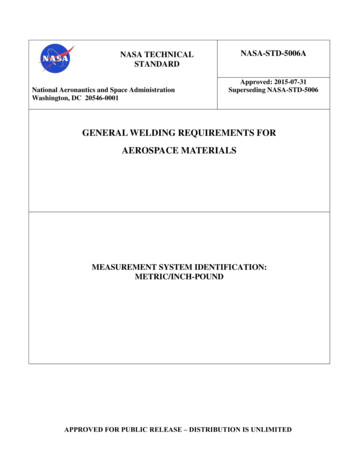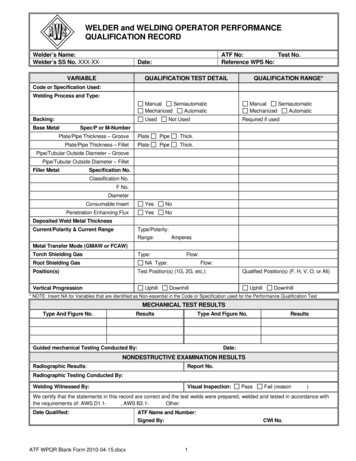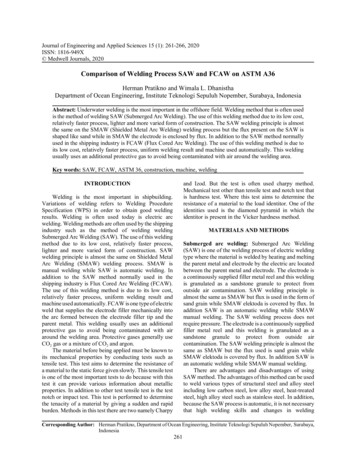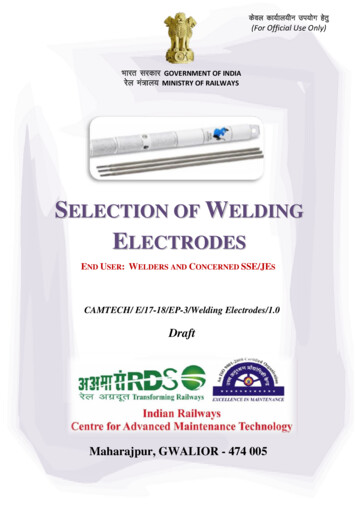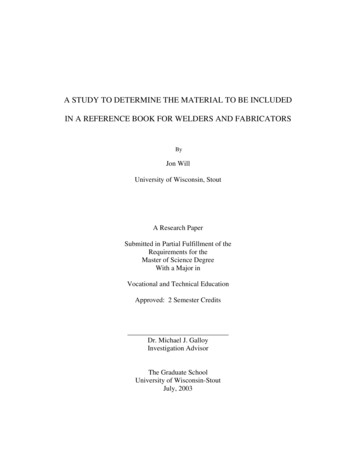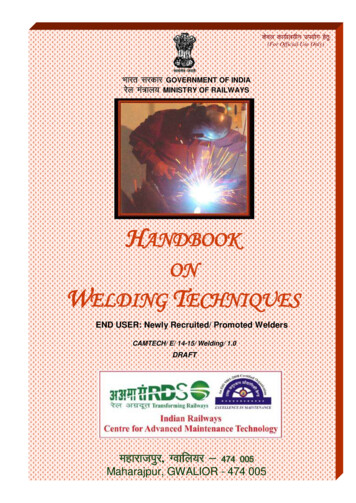
Transcription
dsoy dk;Zky;hu mi;ksx gsrq(For Official Use Only)Hkkjr ljdkj GOVERNMENT OF INDIAjsy ea ky; MINISTRY OF RAILWAYSHANDBOOKONWELDING TECHNIQUESEND USER: Newly Recruited/ Promoted WeldersCAMTECH/ E/ 14-15/ Welding/ 1.0DRAFTegkjktiqj, Xokfy;j & 474 005Maharajpur, GWALIOR - 474 005
HANDBOOKONWELDING TECHNIQUESQUALITY POLICY“To develop safe, modern and costeffective Railway Technologycomplying with Statutory andRegulatory requirements, throughexcellence in Research, Designs andStandards and Continualimprovements in QualityManagement System to cater togrowing demand of passenger andfreight traffic on the railways”.
CONTENTSItem No.DescriptionContents1.IIIGENERAL DESCRIPTION011.1METAL JOINING METHODS011.2COMPARISON BETWEEN WELDING AND OTHER METALJOINING METHODS011.3ADVANTAGES OF WELDING021.4DIFFERENT METHODS OF WELDING021.4.11.4.21.4.30202031.5Fusion welding without pressurePressure weldingNon-fusion weldingCLASSIFICATION OF WELDING PROCESSES ACCORDINGTO HEAT031.6CODES FOR WELDING PROCESSES041.7APPLICATIONS OF VARIOUS WELDING PROCESSES041.8STATES OF MATTER051.9COMMON METALS AND ALLOYS06PROPERTIES OF 122.Page No.Chemical propertiesPhysical propertiesMechanical PropertiesEffect of welding heat on the properties of metalsEFFECT OF ATMOSPHERIC AIR ON WELDINGTYPES OF WELDS08091.12.11.12.21.12.31.12.409091010Bead weldButt weld or groove weldFillet weldsPlug or slot weldsELECTRIC WELDING PROCESSES112.1ELECTRIC WELDING112.2TYPES OF ELECTRIC WELDING112.3ELECTRIC ARC .72.3.8Metallic arc weldingCarbon arc weldingAtomic hydrogen arc weldingTungsten inert gas arc welding (TIG)Gas metal arc welding (GMAW) or Metal inertgas arc welding (MIG)Submerged arc weldingElectro-slag weldingPlasma arc welding13141414
Item No.2.43.DescriptionPage No.SHIELDED METAL ARC WELDING (SMAW)152.4.12.4.22.4.32.4.415151616Salient FeaturesAdvantagesLimitationsApplications2.5ARC LENGTH2.5.1 Medium, normal arc2.5.2 Long arc2.5.3 Short arc161617172.6SAFETY IN MANUAL METAL ARC WELDING2.6.1 Safety apparels2.6.2 Welding hand screens and helmet1718192.7ARC WELDING ACCESSORIES2.7.1 Electrode-holder2.7.2 Earth Clamp2.7.3 Welding cables/ leads202020202.8MATERIAL PREPARATION METHOD2.8.1 Cutting2.8.2 Cleaning2121212.9OPEN CIRCUIT VOLTAGE AND ARC VOLTAGE222.10POLARITY IN DC ARC WELDING2.10.1 Importance of polarity in welding2.10.2 Indication of wrong polarity2222232.11MILD STEEL WELDING ELECTRODES2.11.1 Electrode sizes2.11.2 Functions of an electrode in shielded metal arc welding (SMAW)2.11.3 Identification of Electrodes2.11.4 Types of electrodes23232424252.12FLUX COATED ELECTRODES2.12.1 Merits of Flux coated electrodes2.12.2 Coating factor2.12.3 Types of material used in flux coated electrode2.12.4 Electrode coding26262727272.13WELDING MACHINES (POWER SOURCES)2.13.1 Welding transformer2.13.2 Welding Rectifiers2.13.3 Welding Generator2.13.4 Welding inverters2727282829OXY-ACETYLENE GAS WELDING303.1GAS WELDING303.2OXY-ACETYLENE LENE WELDING EQUIPMENT AND ACCESSORIES313.3.13.3.23131Oxygen gas cylindersDissolved acetylene cylinders
Item No.Description3.3.33.3.43.3.53.3.63.3.73.44.Oxygen pressure regulatorAcetylene regulatorRubber hose pipes and connectionsHose protectorsBlowpipe and nozzlePage No.3131323232SAFETY PRECAUTIONS IN HANDLING OXY-ACETYLENEGAS WELDING PLANT3.4.1 General safety precautions3.4.2 Safety concerning gas cylinders3.4.3 Safety of rubber hose-pipes333334353.5TROUBLE WITH BLOW PIPE & CYLINDERS3.5.1 Backfire3.5.2 Flashback3.5.3 Cylinder catches fire363636373.6TYPES OF OXY-ACETYLENE FLAMES3.6.1 Neutral flame3.6.2 Oxidizing flame3.6.3 Carburizing flame3.6.4 Chemistry of oxy-acetylene flame37373838383.7FILLER RODS FOR GAS WELDING3.7.1 Filler rod and its necessity3.7.2 Sizes as per IS:1278-19723.7.3 Types of filler rods3.7.4 Selection of the filler rod3.7.5 Care and maintenance3.7.6 Different filler metals and fluxes for gas welding393940404041423.8WELDING TECHNIQUES OF OXY-ACETYLENE WELDING3.8.1 Leftward Welding Technique3.8.2 Rightward welding technique4444463.9WELDING OF LOW CARBON STEEL AND MEDIUM CARBONSTEEL3.9.1 Low carbon steels3.9.2 Medium carbon steel3.9.3 High carbon steels45474747OXY-ACETYLENE GAS CUTTING484.1INTRODUCTION484.2PRINCIPLE OF GAS CUTTING484.2.1Cutting Operation484.2.2Application of Cutting Torch49OXY-ACETYLENE CUTTING EQUIPMENT494.3.1Cutting Torch494.3.2Difference between Cutting Torch (Blow Pipe) & welding Blow Pipe494.3.3Care & Maintenance504.3.4Problem with Cutting Torch504.3
Item No.5.DescriptionPage No.FAULTS AND DEFECTS IN GAS WELDING515.1WELD DEFECTS & TYPES515.1.1External Defects515.1.2Internal Defects515.2TYPES OF FAULTS IN GAS WELDING525.3GAS WELD DEFECTS – POSSIBLE CAUSES AND REMEDIES555.4ARC WELD DEFECTS – POSSIBLE CAUSES AND REMEDIES57ANNEXURE - ICLASSIFICATION OF ELECTRODE63ANNEXURE – IIUSAGE & STORAGE OF ELECTRODES66ANNEXURE – IIIGUNA BAR TECHNIQUE FOR REPAIRING OF CRACKEDCAST STEEL BOGIE FRAMESREFERENCES6870
CAMTECH/E/14-15/Welding/1.01CHAPTER 1GENERAL DESCRIPTION1.1METAL JOINING METHODSThe art of joining metals is about 3000 years old. The origin of welding isprobably to be traced to the shaping of metals. In industry every worker is working forchanging the shape of metals by different methods and machines. Welding is a metaljoining method. The following methods are used for joining metals:(i)SolderingThis joint is made on thin metals using solder as a joining medium. The meltingpoint of solder is less than the metals to be joined. The joint can be opened byheating upto the solder melting temperature (below 400 C).(ii)BrazingThe joint is similar to soldering but has more strength. The joining medium usedis brass, which has a higher melting temperature than solder. The joint can also beopened by heating upto the melting point of brass (850-950 C).(iii)WeldingA metal joining method in which the joining edges are heated and fused togetherwith or without filler metal to form a permanent (homogeneous) bond is known aswelding.Or in other words, “Welding is a process of joining two or more pieces of thesame or dissimilar materials to achieve complete coalescence. This is the onlymethod of developing monolithic structures and it is often accomplished by theuse of heat and/or RMETALJOININGJoining methods like riveting, assembling with bolt, seaming, soldering andbrazing all result in temporary joints. Welding is the only method to join metalspermanently.The temporary joints can be separated if:-the head of the rivet is cutnut of the bolt is unscrewedhook of the seam is openedmore heat is given than that required for soldering and brazing.Welded joints cannot be separated like soldering and brazing because it is madehomogeneous by heating and fusing the joining edges together.Handbook on Welding TechniquesDraft
21.3CAMTECH/E/14-15/Welding/1.0ADVANTAGES OF WELDINGWelding is superior to other metal joining methods because it:- is a permanent pressure tight joint- occupies less space- gives more economy of material- has less weight- withstands high temperature and pressure equal to joined material- can be done quickly- gives no colour change to joints.It is the strongest joint and any type of metal of any thickness can be joined.1.4DIFFERENT METHODS OF WELDINGWelding is a method of joining metals permanently. It is an ancient method, about1500 years old. The method used in ancient days was forge or blacksmith welding.One of the methods of classifying welded joints is the method used to effect the jointbetween metal pieces. Accordingly the methods are:- fusion method without pressure/ with pressure- non-fusion method1.4.1 Fusion welding without pressureA method of welding in which similar and dissimilar metals are joined togetherby melting and fusion their joining edges with or without the addition of filler metal butwithout the application of any kind of pressure is known as fusion welding withoutpressure.The joint made is permanent. The common heatingsources are:- arc welding- gas welding- chemical reaction (thermit welding)1.4.2 Pressure weldingThis is a method of welding in which similar metals are joined together byheating them to plastic or partially molten state and then joined by pressing orhammering without the use of filler metal. This is fusion method of joining with pressure.Heat source may be blacksmith forge (forge welding) or electric resistance (resistancewelding) or friction.DraftHandbook on Welding Techniques
CAMTECH/E/14-15/Welding/1.031.4.3 Non-fusion weldingThis is a method in which similar or dissimilar metals are joined together withoutmelting the edges of the base metal by using a low melting point filler rod but without theapplication of pressure.1.5CLASSIFICATION OF WELDING PROCESSES ACCORDING TO HEATSOURCEAccording to the sources of heat, welding processes can be broadly classified as:- Electric welding processes (heat source is electricity)- Gas welding processes (heat source is gas flame)- Other welding processes (heat source is neither electricity nor gas flame) Electric welding processes can be classified as:- Electric arc welding- Electric resistance welding- Laser welding- Electron beam welding- Induction welding Electric arc welding can be further classified as:- Metallic arc welding- Carbon arc welding- Atomic hydrogen arc welding- Inert gas arc welding/ TIG welding- CO2 gas arc welding- Flux cored arc welding- Submerged arc welding- Electro-slag welding- Plasma arc welding Electric resistance welding can be further classified as:- Spot welding- Seam welding- Butt welding- Flash butt welding- Projection welding Gas welding processes can be classified as:- Oxy-acetylene gas welding- Oxy-hydrogen gas welding- Oxy-coal gas welding- Oxy-liquefied petroleum gas welding- Air acetylene gas weldingHandbook on Welding TechniquesDraft
4CAMTECH/E/14-15/Welding/1.0 1.6The other welding processes are:- Thermit welding- Forge welding- Friction welding- Ultrasonic welding- Explosive welding- Cold pressure welding- Plastic weldingCODES FOR WELDING AWSCAWTW1.7DraftWelding processAir acetyleneBare metal arcElectron beamElectro slagFlashGas carbon arcGas tungsten arcLaser beamOxy-hydrogenPressure gasResistance seamSubmerged arcShielded carbon MAWSWUWWelding processAtomic hydrogenCarbon arcElectro gasFlux cored arcFLOWGas metal arcInductionOxy-acetylenePlasma arcResistance projectionResistance spotShielded metal arcStud arcUltrasonicAPPLICATIONS OF VARIOUS WELDING PROCESSES Forge welding is used in olden days for joining metals as a lap and butt joint. Metallic arc welding is used for welding all ferrous and non-ferrous metals usingconsumable stick electrodes. Carbon arc welding is used for welding all ferrous and non-ferrous metals usingelectrodes and separate filler metal. But this is a slow welding process and so notuse now-a-days. Submerged arc welding is used for welding ferrous metals, thicker plates and formore production. CO2 welding (gas metal arc welding) is used for welding ferrous metals usingcontinuously fed filler wire and shielding the weld metal and the arc by carbon-dioxide gas. TIG welding (inert gas arc welding) is used for welding ferrous metals, stainlesssteel, aluminium and thin sheet metal welding. Atomic hydrogen welding is used for welding all ferrous and non-ferrous metalsand the arc has a higher temperature than other arc welding processes.Handbook on Welding Techniques
CAMTECH/E/14-15/Welding/1.01.85 Electro-slag welding is used for welding very thick steel plates in one pass usingthe resistance property of the flux material. Plasma arc welding: The arc has a very deep penetrating ability into the metalswelded and also the fusion is taking place in a very narrow zone of the joint. Spot welding is used for welding thin sheet metal as a lap joint in small spots byusing the resistance property of the metals being welded. Seam welding is used for welding thin sheets similar to spot welding. But adjacentweld spots will be overlapping each other to get a continuous weld seam. Projection welding is used to weld two plates one over the other on their surfacesinstead of the edges by making projection on one plate and pressing it over the otherflat surface. Each projection acts as a spot weld during welding. Butt welding is used to join the ends of two heavy section rods/ blocks together tolengthen it using the resistance property of the rods under contact. Flash butt welding is used to join heavy sections of rods/ blocks similar to buttwelding except that arc flashes are produced at the joining ends to melt them beforeapplying heavy pressure to join them. Oxy-acetylene welding is used to join different ferrous and non-ferrous metals,generally of 3 mm thickness and below. Oxy-other fuel gases welding: Fuel gases like hydrogen, coal gas, liquefiedpetroleum gas (LPG) are used along with oxygen to get a flame and melt the basemetal and filler rod. Since the temperatures of these flames are lower than the oxyacetylene flame, these welding are used to weld metals where less heat input isrequired. Air-acetylene gas welding is used for solder, heating the job etc. Induction welding is used to weld parts that are heated by electrical induction coilslike brazing of tool tips to the shank, joining flat rings etc. Thermit welding is used for joining thick, heavy irregularly shaped rods, like rails,etc using chemical heating process. Friction welding is used to join the ends of large diameter shafts etc. by generatingthe required heat using the friction between their ends in contact with each other byrotating one rod against the other rod.STATES OF MATTERThere are three states of matter exist as: Solid Liquid GasIn welding, a metal to be welded will be in the solid state before welding. Duringwelding the solid state changes to liquid state and at the end of the welding operation, theliquid state again changes to solid state.Handbook on Welding TechniquesDraft
61.9CAMTECH/E/14-15/Welding/1.0COMMON METALS AND ALLOYSMetals may be ferrous, non-ferrous metals and alloys.Ferrous metals are those which have iron as their base. They include iron and its alloyssuch as steel, cast iron and alloy steels such as stainless steel etc.Non-ferrous metals do not contain iron as base. They include copper, aluminium, zinc,tin etc and non-ferrous alloys.AlloysIf two or more metals are chemically combined they form an alloy e.g. iron,chromium nickel and carbon form an alloy called chromium nickel steel (stainless),manganese, iron and carbon form an alloy called manganese steel, copper and zinc forman alloy called brass, copper and tin form an alloy called bronze, lead and tin form analloy called soft solder.1.10PROPERTIES OF METALSProperties of metals can be classified mainly into: Chemical properties Physical properties Mechanical properties1.10.1 Chemical propertiesChemical properties are those which involve chemical effect such as: Corrosion Oxidation ReductionCorrosion will spoil the metal surface due to the effect of various elements in theatmosphere and water.Oxidation is the formation of metal oxides which occur when oxygen combines withmetals.Reduction refers to the removal of oxygen from the surrounding molten puddle to reducethe effect of atmospheric contamination.1.10.2 Physical propertiesPhysical properties are those, which affect metals when they are subjected to heatgenerated by welding such as: melting point thermal conductivity thermal expansion grain growthDraftHandbook on Welding Techniques
CAMTECH/E/14-15/Welding/1.07Melting pointMelting point is the degree of temperature, when a solid metal changes into liquid.Melting points of some metals are given below:1.Mild steel1500 to 1530 C2.Cast iron1150 C3.Copper1083 C4.Aluminium659 C5.Brass and bronze850 C-950 C6.Zinc419 C7.Tin232 C8.Lead327 C9.Nickel1452 C10Soft solder(50% lead, 50% tin)Thermal conductivityThermal conductivity is the rate at which a metal conducts heat to the adjacent area ofthe heated job. Copper conducts heat faster than aluminium. Aluminium conducts heatfaster than iron.Thermal expansionWhenever metals are heated there will be increase in its dimensions due to their thermalexpansion property. Depending on the nature of metal, different metals will havedifferent thermal expansion.Grain structureLike salt or sugar, the metal is also a crystalline substance. In metals the crystals arecalled grains. Grains are composed of atoms. Atomic structure determines the grainstructure just as the arrangement of bricks determines the shape of the building. Duringwelding (due to heating effect) the grain size increases resulting in the loss of strength.1.10.3 Mechanical PropertiesMechanical properties are those which determine the behavior of metals under appliedload such as: Tensile strength Ductility Hardness Toughness BrittlenessTensile strength is the property of the metal which resists forces acting to pull it apart.Ductility is the ability of the metal to stretch, bend or twist without breaking or crackingor to draw into fine wires.Handbook on Welding TechniquesDraft
8CAMTECH/E/14-15/Welding/1.0Hardness is the ability of the metal to withstand abrasions, cutting action by a tool.Usually any hard metal will resist the compressive forces. Normally a hard metal willalso be brittle.Toughness is the ability of a metal to withstand sudden force without breaking.Brittleness is the property of the metal which is opposite of ductility and is applied to ametal which cracks suddenly if placed pressure or load to bend or twist.1.10.4 Effect of welding heat on the properties of metalsDuring welding the properties of the weld metal may be affected. Important alloying elements may be destroyed. Brittle, hard or cracked welds may be produced. There may be reduction in the corrosion resistance properties of the welds. Main properties of the base metal and weld metal will get affected1.11EFFECT OF ATMOSPHERIC AIR ON WELDINGThe atmospheric air is a gaseous mixture of mainly nitrogen and oxygen, withsome other gases like hydrogen, etc. in small percentages.Since the atmospheric air contains 21% of oxygen, whenever a red hot or molteniron comes in contact with atmospheric air the metal gets oxidized.Oxygen contamination i.e. oxidation will reduce the mechanical properties of theweld metal. In other words the tensile strength, toughness and ductility of the welddecrease with increased oxygen contamination.The nitrogen injected into the weld pool, during the solidification of the weldmetal, forms bubbles and results in the formation of gas porosity in the weld metal. Thisreduces the strength of the joint. In addition, the atmospheric nitrogen will combine withthe molten metal and the weld hardened due to the formation of iron nitride. For theabove reason the weld metal must be protected from the atmospheric contaminationeither by using suitable flux or with insert gas shielding.If there is more moisture (water) present in the atmospheric air (particularlyduring rainy and winter season) the iron gets oxidized (i.e. rusted) due to long storage.The formation of oxides and nitrides due to the contact of atmospheric air withthe molten metal is also called as atmospheric contamination.Effects of oxidationDuring the welding process the combination of a metal with oxygen (oxide) may causethe following effects:i. Produce blow holes in the weld beads.ii. Produce oxides which are having a higher melting point than that of the surroundingmetals. This will form solid particles (oxide inclusions) in the weld metal in the caseof non-ferrous metals.DraftHandbook on Welding Techniques
CAMTECH/E/14-15/Welding/1.09iii. Produce oxides which will dissolve in the molten metal and make the metal brittleand weak.iv.The oxides of wrought iron and steel melt at a temperature lower than that of theparent metal, and being light, float to the surface as a scale.If care is taken in the welding process, the oxides will not cause troubleduring welding.There are some effects of oxidation on the filler rods, powder type fluxes used ingas welding and on the electrode core wire and the flux coated on them. If proper care isnot taken to protect the filler rods, fluxes and M.S. coated electrodes to store themproperly, they will get rusted. The fluxes will pick up moisture from the wet atmosphereand will become useless/ deteriorated.However, the oxidation of metals has also certain useful effects i.e. a stream ofpure oxygen if applied (used) on a red hot mild steel plate through a nozzle, the plate willget cut into 2 pieces. Hence the principle of oxidation is effectively used in Gas cuttingand gouging of mild steel.1.12TYPES OF WELDSTo get different welding joints the following types of weld are used: Bead weld Groove or butt weld Fillet weld Plug or slot weld1.12.1 Bead weldBead weld is a type of weld composed of one or morestringer or weave beads deposited on an unbroken surfaceto obtain the desired properties and dimensions.1.12.2 Butt weld or groove weldButt weld or groove weld is a weld made in the groove between two members to bejoined as butt joint. Groove welds are also done on T fillet joints if the plate thickness ismore than 12mm.Handbook on Welding TechniquesDraft
101.12.3CAMTECH/E/14-15/Welding/1.0Fillet weldsFillet weld is a weld, having a triangular cross-section, joining two surfaces at rightangle to each other such as: Lap joint Tee joint Corner joint1.12.4 Plug or slot weldsPlug or slot welds are welds used to join two over-lapping pieces of metal by weldingthrough circular holes or slots. These welds are often used in the place of rivets.DraftHandbook on Welding Techniques
CAMTECH/E/14-15/Welding/1.011CHAPTER 2ELECTRIC WELDING PROCESSES2.1ELECTRIC WELDINGThis is a process of welding in which the heat energy is obtained from electricity.Formula for converting electrical energy to heat energyH I2RTWhereHis the amount of heat produced in ‘joules’.Iis the amount of current passing in amps.Ris the resistance of medium in ohms.Tis the time during which the current flows.This is useful only in the resistance welding process.2.2TYPES OF ELECTRIC WELDINGThere are mainly two types of electric welding processes classified as follows:(i)Electric arc weldingIt is a fusion-welding (nonpressure) process in which thewelding heat is obtained from anarc,formedbetweenanelectrode and the welding jobconnected to a suitable weldingmachine.(ii)Electric resistance weldingIt is a pressure-welding process inwhich the heat is obtained by passinga heavy momentary electric currentthroughtheinherentelectricresistance of the joint to be welded.When the joint reaches a plastic state,sufficient pressure is applied toproducefusionandgetahomogeneous weld.Handbook on Welding TechniquesDraft
122.3CAMTECH/E/14-15/Welding/1.0ELECTRIC ARC WELDINGElectric arc is formed when both the terminals of an electric circuit are broughttogether and then separated by a small gap. When high current passes through an air gapfrom one conductor to another, it produces very intense and concentrated heat in the formof a spark. The temperature of this spark (or arc) is app. 3600 C, which can melt and fusethe metal very quickly to produce a homogeneous weld. The types of electric arc weldingare as follow.2.3.1 Metallic arc weldingThis is an arc welding process in which thewelding heat is obtained from an arc, formed betweena metallic (consumable) electrode and welding job.The metal electrode melts itself and acts as a fillermetal.2.3.2 Carbon arc weldingHere the arc is formed between a carbonelectrode (non-consumable) and the welding job.A separate filler rod is used since the carbonelectrode is a non-metal and will not melt.2.3.3 Atomic hydrogen arc weldingIn this process the arc is formed betweentwo tungsten electrodes in an atmosphere ofhydrogen gas. The welding job remains out ofthe welding circuit and a separate filler rod isused to add the filler metal.2.3.4 Tungsten inert gas arc welding (TIG)DraftHandbook on Welding Techniques
CAMTECH/E/14-15/Welding/1.013In this process the arc is formed between the tungsten electrodes (nonconsumable) and the welding job in an atmosphere of an inert gas (argon or helium). Aseparate filler rod is used to add the filler metal. This process is also called gas tungstenarc welding (GTAW) process.2.3.5 Gas metal arc welding (GMAW) or Metal inert gas arc welding (MIG)In this process the arc is formed between a continuous, automatically fed, metallicconsumable electrode and welding job in an atmosphere of inert gas, and hence this iscalled metal inert gas arc welding (MIG) process.When the inert gas is replaced by carbon dioxide then it is called CO2 arcwelding or metal active gas (MAG) arc welding.The common name for this process is gas metal arc welding (GMAW).2.3.6 Submerged arc weldingHandbook on Welding TechniquesDraft
14CAMTECH/E/14-15/Welding/1.0In this process the arc is formed between a continuous, automatically fed, metallicconsumable electrode and the welding job under a heap of powdered/ granulated flux.The arc is totally submerged in the flux (invisible).2.3.7 Electro-slag weldingThe arc is formed between a continuous,automatically fed,metallic consumableelectrode and the welding job under a thick poolof molten flux (slag). This automatic processrequires special equipment and is used only invertical position for the welding of heavy thickplates.2.3.8 Plasma arc weldingIn this process the arc is formedbetween a tungsten electrode and the weldingjob in an atmosphere of plasma-forming gasnitrogen, hydrogen and argon. A separatefiller rod is used to add the filler metal in thejoint, if necessary. But normally no filler rodis used.The process is similar to TIG welding.Plasma cutting is used to cut non-ferrous metals and alloys successfully and quickly.2.4DraftSHIELDED METAL ARC WELDING (SMAW)Handbook on Welding Techniques
CAMTECH/E/14-15/Welding/1.0152.4.1 Salient Features It is an arc welding process in which the heat required for the welding comes froman electric arc. The electric arc develops when electricity jumps across an air gap (ionization of air)between the end of the metallic electrode and the welding job surface. The metallic electrode is generally coated with a flux which is consumable. The arc created due to the ionization of air between the electrode tip and the basemetal generates an intense arc heat having a temperature between 3600 C-4000 C. The welding current is provided by an AC or DC machine. The intense heat of the arc melts a small portion (molten pool) on the job directlyunder the arc and at the end of the electrode instantaneously. The melted electrode fuses into the molten pool of the welding job and produces ahomogeneous weld on cooling. The flux coating on the electrodealso melts and provides a gaseousshield around the arc which protectsthe molten metal from atmosphericcontamination. Hence this is calledshielded metal arc welding(SMAW). The welding speed and feed of theelectrode is controlled manually bythe welder himself. So it is alsocalled manual metal arc welding(MMAW). When the weld metal solidifies, the slag (of flux coating) gets deposited on itssurface as it is lighter than the metal and the weld metal is allowed to cool graduallyand slowly.2.4.2 AdvantagesThe process is widely used because of the following advantages: All kinds of light and heavy gauge metals can be welded. It can be used for fabrication, construction as well as maintenance works. All types of metals (ferrous, non-ferrous and alloys) can be welded. It permits a skilled operator to perform the welding operation quickly and easily. It is more suitable for short length welds. It is less expensive than the other processes. It is less sensitive to weld than the other arc welding processes. It is portable.2.4.3 LimitationsHandbook on Welding TechniquesDraft
16CAMTECH/E/14-15/Welding/1.0 Less metal is deposited per hour and so can not be used for heavy fabricationwelding. Requires more welders to be employed. Controlling the distortion is difficult. Continuous and automatic welding is not possible due to the specific length of theelectrode. More strain to the welder.2.4.4 Applications2.5 It is used for welding thin gauge as well as thick gauge metals in small andmedium scale industries. Used in welding bridges, bus bodies, domestic items like grills for gate, windows,doors, chairs and tables. Used in welding roof structures for workshops, broken and cracked castings,water and oil tanks. Whenever welding is done in outdoor work, this process is very useful as a dieselgenerator welding set can be used. This process is used for reconditioning, hard facing, rectifying broken parts andrepair welding.ARC LENGTHIt is the straight distance between the electrode tip and the job surface when the arc isformed. There are three types of arc lengths:-Medium or normal-Long-Short3.4.1 Medium, normal arcThe correct arc length or normal arc length isapproximately equal to the diameter of the core wireof the electrode. This is a stable arc producing steadysharp cracking sound and causing:-Even burning of the electrode-Reduction in spatters-Correct fusion and penetration-Correct metal depositionIt is used to weld mild steel using a mediumcoated electrode. It can be used for the final coveringrun to avoid undercut and excessive convex fillet/reinforcement.DraftHandbook on Welding Techniques
CAMTECH/E/14-15/Welding/1.0173.4.2 Long arcIf the distance between the tip of theelectrode and the base metal is more than thediameter of the core wire it is called a longarc. It makes a humming sound causing:- unstable arc- oxidation of weld metal- poor fusion and penetration- poor control of molten metal- more spatters, indicat
(iii) Welding A metal joining method in which the joining edges are heated and fused together with or without filler metal to form a permanent (homogeneous) bond is known as welding. Or in other words, “Welding is a process of joining two or more pieces of the same or dissimilar ma


